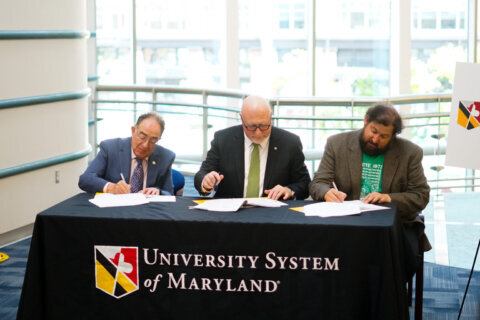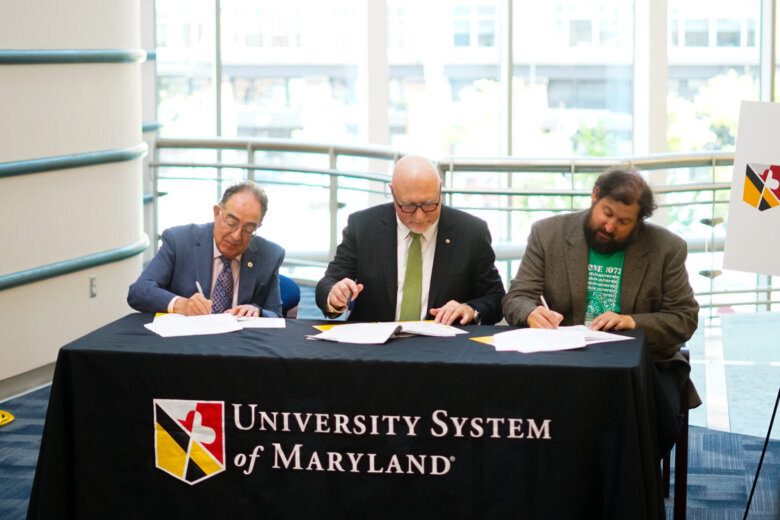This article was republished with permission from WTOP’s news partners at Maryland Matters. Sign up for Maryland Matters’ free email subscription today.

The University System of Maryland signed a multicampus contract with the American Federation of State, County and Municipal Employees on Friday that will standardize labor benefits for workers at nine campuses in Maryland.
The contract and memorandum of understanding cover approximately 5,700 non-faculty university employees for the next three years. That’s about 95% of the unionized workers at the nine campuses, according to a statement from both parties.
It is the first consolidated contract of its kind between the system and the union, and presidents of various AFSCME locals said it “levels the playing field” for workers at different campuses.
“I feel ecstatic, so proud of our members and so proud of what they accomplished, and that they stuck with it. And they worked hard. They had a goal. And we accomplished that goal today,” said Patrick Moran, the president of AFSCME Council 3, the Maryland chapter of the union.
Del. Jared Solomon (D-Montgomery) echoed Moran.
“This is the culmination of a lot of hard work on both sides that gets us to a place, frankly, that I think really honors our employees … but gives the university system the flexibility to continue to do what it needs to do to be one of the best in the country,” Solomon said.
The universities included in the contract are the University of Maryland campuses at College Park, Eastern Shore, Baltimore, Baltimore County and the Global Campus, along with Bowie State, Coppin State, Frostburg State and the University of Baltimore.
The agreement raised the minimum salary to $38,000 per year and increased the minimum of each pay grade for salaried employees by 5%, effective July 1. It also guarantees raises in each of the remaining two years of the contract.
Employees will also earn more annual leave and be able to keep more of it from year to year, will have access to tuition remission for themselves, their spouses and dependent children, among other benefits.
Discussion of a multicampus contract began in 2021 after lawmakers passed a bill, directing the chancellor to begin negotiations – a process that was derailed by then-Gov. Larry Hogan’s veto, which was later overriden.
Solomon said there was a lot of “back and forth” in constructing the legislation that led to Friday’s agreement. Union officials welcomed the signing.
“So I think this should help get money for the other universities, it’s showing us all equally and, all the money and other things should be all shared all the way across – leveling the playing field, at least, is going to be the beginning,” said Jontae Thomas, the president of AFSCME Local 1297 at Bowie State University.
Todd Holden, the president of AFSCME Local 1072 at College Park and the Global Campus, echoed Thomas, mentioning the difference between before and after the signing.
“Under the old regime it was a broader issue that the differences in the experience of a housekeeper at Frostburg would differ wildly from the experience for a housekeeper at UMB (the University of Maryland Baltimore) for instance,” Holden said. “And the consolidated agreement standardized that.”
Holden and Thomas both feel that the job isn’t finished, and that there’s more work to be done to ensure equitable working conditions at all universities.
“There’s a long way to go. It’s just the beginning,” Thomas said. “It’s a lot more that we need to touch up on: We need more money for the universities for the upkeep, we need to move raises up so people can live better, a lot of people that’s working at these universities are in poverty.”
Holden said the agreement is a first step to fixing what he called a disconnect between the image of labor relations in the state and the reality.
“As a progressive state, as Maryland likes to, to style itself, people are often surprised at what the real landscape of unions and labor relations are,” Holden said. “I think that for us, this is a good first step in really trying to align the reality of labor relations in Maryland, to what people’s perception of it should be.”








